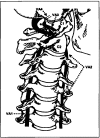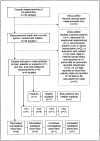Vertebral Artery Blood flow Velocity Changes Associated with Cervical Spine rotation: A Meta-Analysis of the Evidence with implications for Professional Practice
- PMID: 20046565
- PMCID: PMC2704344
- DOI: 10.1179/106698109790818160
Vertebral Artery Blood flow Velocity Changes Associated with Cervical Spine rotation: A Meta-Analysis of the Evidence with implications for Professional Practice
Abstract
Many studies of vertebral artery (VA) blood flow changes related to cervical spine rotation have been published, but the findings are controversial and the evidence unconvincing. Recent Doppler measurements suggest that contralateral VA blood flow is compromised on full rotation in both healthy subjects and patients. More rigorous research is needed, and it was the aim of this study to conduct a meta-analysis of published data to inform professional practice. A systematic literature search, including only Doppler studies of VA blood flow velocity associated with cervical spine rotation in adults, yielded nine reports with published data. Using weighted means of the pooled data, the magnitude of the effect size (Cohen's d) was calculated for differences between patients and subjects, sitting or lying supine for testing, the parts of the VA insonated, and the changes recorded after cervical spine rotation. From this meta-analysis, VA blood flow velocity was found to be compromised more in patients than healthy individuals, on contralateral rotation, with the subject sitting, and more in the intracranial compared to the cervical part of the VA. Possible reasons for these findings are suggested, and it is advised that sustained end-of-range rotation and quick-thrust rotational manipulations be avoided until there is a stronger evidence base for clinical practice.
Keywords: Blood Flow; Cervical Spine Rotation; Physical Therapy; Vertebral Artery.
Figures


Similar articles
-
Is mechanical deformation of the suboccipital vertebral artery during cervical spine rotation responsible for vertebrobasilar insufficiency?Physiother Res Int. 2008 Mar;13(1):53-66. doi: 10.1002/pri.370. Physiother Res Int. 2008. PMID: 17624896 Review.
-
Real-time ultrasound measurements of changes in suboccipital vertebral artery diameter and blood flow velocity associated with cervical spine rotation.Physiother Res Int. 2008 Dec;13(4):241-54. doi: 10.1002/pri.400. Physiother Res Int. 2008. PMID: 18504783
-
Doppler insonation of vertebral artery blood flow changes associated with cervical spine rotation: Implications for manual therapists.Physiother Theory Pract. 2007 Nov-Dec;23(6):303-13. doi: 10.1080/09593980701593771. Physiother Theory Pract. 2007. PMID: 18075904 Review.
-
Changes in vertebral artery blood flow following normal rotation of the cervical spine.J Manipulative Physiol Ther. 2003 Jul-Aug;26(6):347-51. doi: 10.1016/S0161-4754(03)00074-5. J Manipulative Physiol Ther. 2003. PMID: 12902962
-
Changes in Vertebral Arterial Blood Flow During Premanipulative Tests in Participants With Upper Cervical Spine Motion Restriction.J Manipulative Physiol Ther. 2020 Feb;43(2):134-143. doi: 10.1016/j.jmpt.2019.10.002. Epub 2020 Apr 17. J Manipulative Physiol Ther. 2020. PMID: 32312607 Clinical Trial.
Cited by
-
Effects of Head Position on Cerebral Oxygenation and Blood Flow Velocity During Thyroidectomy.Turk J Anaesthesiol Reanim. 2016 Oct;44(5):241-246. doi: 10.5152/TJAR.2016.77598. Epub 2016 Oct 1. Turk J Anaesthesiol Reanim. 2016. PMID: 27909604 Free PMC article.
-
Kinematics of the head and associated vertebral artery length changes during high-velocity, low-amplitude cervical spine manipulation.Chiropr Man Therap. 2022 Jun 1;30(1):28. doi: 10.1186/s12998-022-00438-0. Chiropr Man Therap. 2022. PMID: 35650649 Free PMC article.
-
Effect of cervical manipulation on vertebral artery and cerebral haemodynamics in patients with chronic neck pain: a crossover randomised controlled trial.BMJ Open. 2019 May 28;9(5):e025219. doi: 10.1136/bmjopen-2018-025219. BMJ Open. 2019. PMID: 31142519 Free PMC article. Clinical Trial.
-
The Enduring Controversy of Cervicogenic Vertigo, and Its Place among Positional Vertigo Syndromes.Audiol Res. 2021 Sep 26;11(4):491-507. doi: 10.3390/audiolres11040045. Audiol Res. 2021. PMID: 34698085 Free PMC article. Review.
-
The ligamentous cervical instability etiology of human disease from the forward head-facedown lifestyle: emphasis on obstruction of fluid flow into and out of the brain.Front Neurol. 2024 Nov 27;15:1430390. doi: 10.3389/fneur.2024.1430390. eCollection 2024. Front Neurol. 2024. PMID: 39677863 Free PMC article.
References
-
- De Kleyn A, Nieuwenhuyse AC. Vertigo and nystagmus with various head positions. Acta Otolaryngol. 1927;11:155–157.
-
- Tissington-Tatlow WF, Brammer HG. Syndrome of vertebral artery compression. Neurology. 1957;7:331–340. - PubMed
-
- Toole JF, Tucker SH. Influence of head position upon cerebral circulation. Arch Neurol. 1960;2:616–623. - PubMed
-
- Brown BSTJ, Tissington-Tatlow WF. Radiographic studies of the vertebral arteries in cadavers. Radiology. 1963;81:80–88. - PubMed
-
- Selecki BR. The effects of rotation of the atlas on the axis: Experimental work. Med J Aust. 1969;1:1012–1015. - PubMed
LinkOut - more resources
Full Text Sources
